warning Alfa Romeo 8C 2010 Owner handbook (in English)
[x] Cancel search | Manufacturer: ALFA ROMEO, Model Year: 2010, Model line: 8C, Model: Alfa Romeo 8C 2010Pages: 223, PDF Size: 14.35 MB
Page 5 of 223
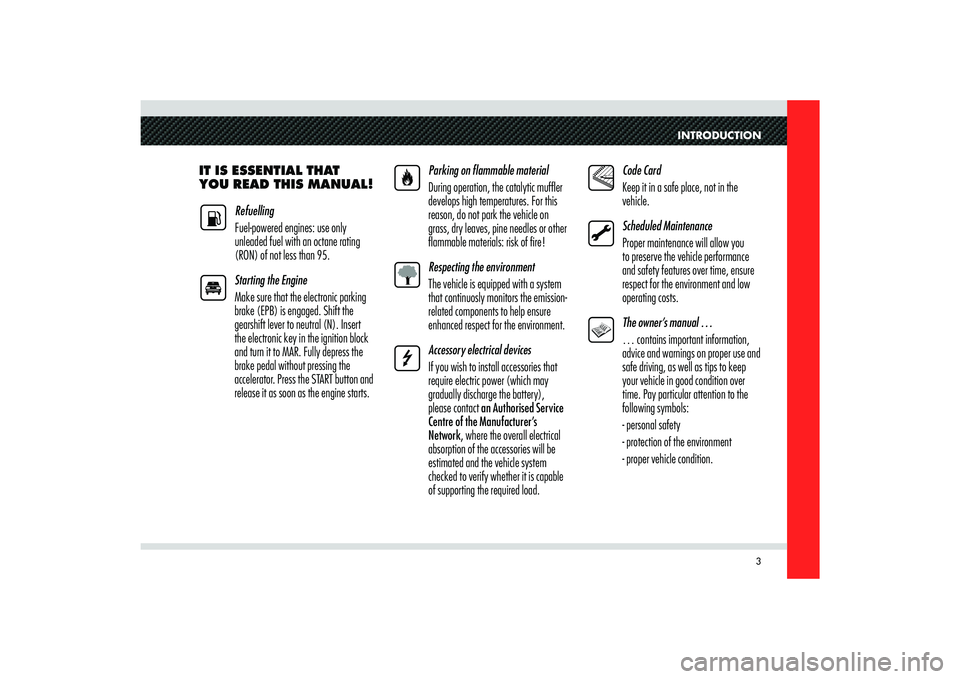
INTRODUCTION
3
IT IS ESSENTIAL THAT
YOU READ THIS MANUAL!
Refuelling
Fuel-powered engines: use only
unleaded fuel with an octane rating
(RON) of not less than 95.
Starting the Engine
Make sure that the electronic parking
brake (EPB) is engaged. Shift the
gearshift lever to neutral (N). Insert
the electronic key in the ignition block
and turn it to MAR. Fully depress the
brake pedal without pressing the
accelerator. Press the START button and
release it as soon as the engine starts.Parking on fl ammable material
During operation, the catalytic muffl er
develops high temperatures. For this
reason, do not park the vehicle on
grass, dry leaves, pine needles or other
fl ammable materials: risk of fi re!
Respecting the environment
The vehicle is equipped with a system
that continuosly monitors the emission-
related components to help ensure
enhanced respect for the environment.
Accessory electrical devices
If you wish to install accessories that
require electric power (which may
gradually discharge the battery),
please contact an Authorised Service
Centre of the Manufacturer’s
Network, where the overall electrical
absorption of the accessories will be
estimated and the vehicle system
checked to verify whether it is capable
of supporting the required load. Code Card
Keep it in a safe place, not in the
vehicle.
Scheduled Maintenance
Proper maintenance will allow you
to preserve the vehicle performance
and safety features over time, ensure
respect for the environment and low
operating costs.
The owner’s manual …
… contains important information,
advice and warnings on proper use and
safe driving, as well as tips to keep
your vehicle in good condition over
time. Pay particular attention to the
following symbols:
- personal safety
- protection of the environment
- proper vehicle condition.
Page 6 of 223
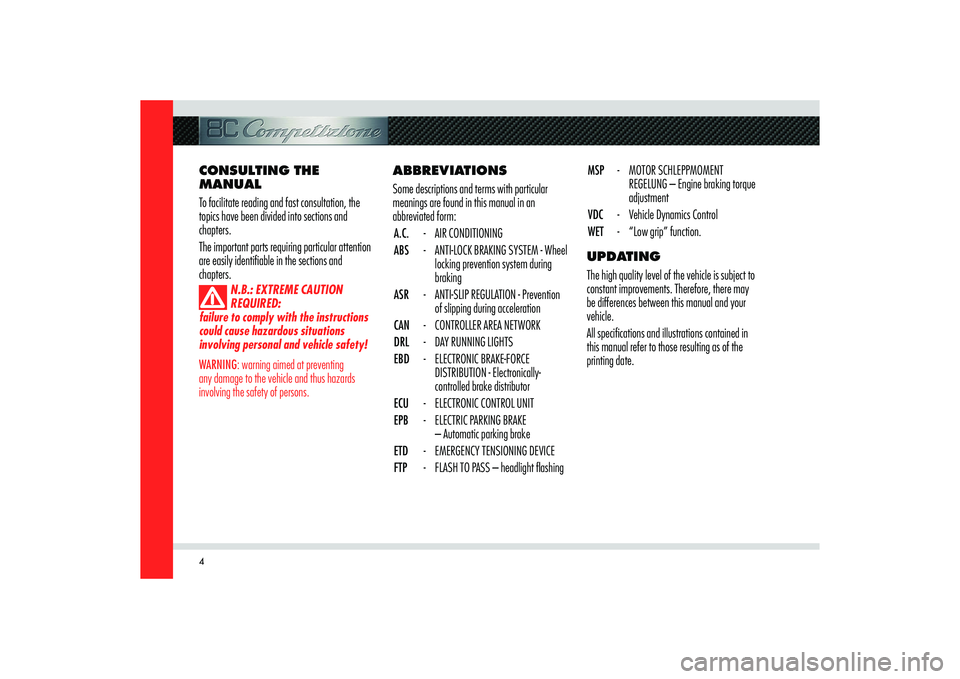
4
ABBREVIATIONS
Some descriptions and terms with particular
meanings are found in this manual in an
abbreviated form:
A.C. - AIR CONDITIONING
ABS - ANTI-LOCK BRAKING SYSTEM - Wheel
locking prevention system during
braking
ASR - ANTI-SLIP REGULATION - Prevention
of slipping during acceleration
CAN - CONTROLLER AREA NETWORK
DRL - DAY RUNNING LIGHTS
EBD - ELECTRONIC BRAKE-FORCE
DISTRIBUTION - Electronically-
controlled brake distributor
ECU - ELECTRONIC CONTROL UNIT
EPB - ELECTRIC PARKING BRAKE
– Automatic parking brake
ETD - EMERGENCY TENSIONING DEVICE
FTP - FLASH TO PASS – headlight fl ashingMSP - MOTOR SCHLEPPMOMENT
REGELUNG – Engine braking torque
adjustment
VDC - Vehicle Dynamics Control
WET - “Low grip” function.
UPDATING
The high quality level of the vehicle is subject to
constant improvements. Therefore, there may
be differences between this manual and your
vehicle.
All specifi cations and illustrations contained in
this manual refer to those resulting as of the
printing date. CONSULTING THE
MANUAL
To facilitate reading and fast consultation, the
topics have been divided into sections and
chapters.
The important parts requiring particular attention
are easily identifi able in the sections and
chapters.
N.B.: EXTREME CAUTION
REQUIRED:
failure to comply with the instructions
could cause hazardous situations
involving personal and vehicle safety!
WARNING: warning aimed at preventing
any damage to the vehicle and thus hazards
involving the safety of persons.
Page 8 of 223

6SYMBOLSSome components of your ALFA ROMEO, are
equipped with coloured labels, applied onto
or next to them. The symbols shown on these
labels are important warnings that the user must
follow when using the component involved.
Below is a summary of all the symbols used
on the labelling of your ALFA ROMEO. The
component to which the symbol draws your
attention is shown next to the symbol.
In addition, the meaning of the symbol shown
is also indicated according to the following
sub-division: danger, prohibition, warning,
mandatory - with respect to that same symbol.DANGER SYMBOLS
Battery
Corrosive liquid.
Battery
Explosion.
Fan
It can start up automatically even with
the engine off.
Expansion tank
Do not remove the cap when the
coolant is hot.
Coil
High voltage.
Belts and pulleys
Moving elements; Keep body parts and
clothing away.
Air-conditioning lines
Do not open. Gas under high pressure.SYMBOLS OF
PROHIBITIONS
Battery
Do not approach with open fl ames.
Battery
Keep children at a safe distance.
Heat guards - belts - pulleys - fans
Do not touch with your hands.
Engine compartment ECU protection
cover
Do not direct the jet of water on the
ECUs, relays and fuses.
Page 9 of 223

INTRODUCTION
7
WARNING SYMBOLS
Catalytic muffl er
Do not park the vehicle over fl ammable
materials. Refer to section: “Air Quality
devices”.
Hydraulic steering
Do not exceed the maximum
level of fl uid in the tank. Only use
fl uid of the type prescribed in the
section “Capacities and technical
specifi cations”.
Braking system
Do not exceed the maximum level
of fl uid in the tank. Only use fl uid
of the type recommended in the
section “Capacities and technical
specifi cations”.Windscreen wiper
Only use fl uid of the type recommended
in the section “Capacities and technical
specifi cations”.
Engine
Only use the lubricant recommended in
the section “Capacities and Technical
specifi cations”.
Vehicle using unleaded fuel
Only use unleaded fuel with an octane
number (R.O.N.) of no less than 95.
Expansion tank
Only use fl uid of the type recommended
in the section “Capacities and technical
specifi cations”.SYMBOLS INDICATING
MANDATORY MEASURES
Battery
Protect your eyes.
Page 16 of 223
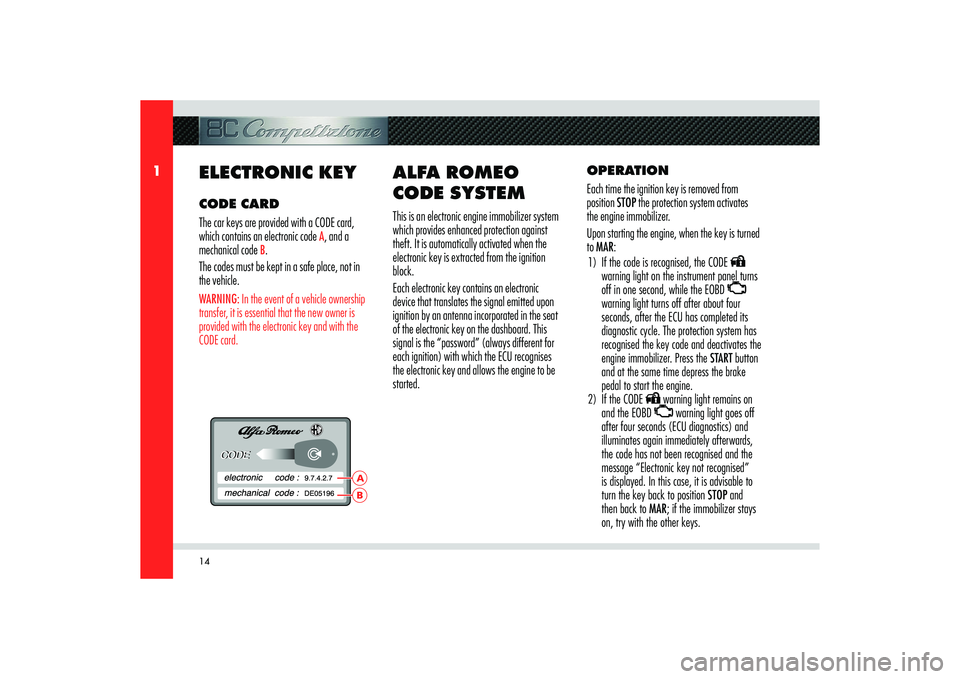
14
1
BA
ELECTRONIC KEYCODE CARD
The car keys are provided with a CODE card,
which contains an electronic code
A, and a
mechanical code
B.
The codes must be kept in a safe place, not in
the vehicle.
WARNING: In the event of a vehicle ownership
transfer, it is essential that the new owner is
provided with the electronic key and with the
CODE card.
ALFA ROMEO
CODE SYSTEMThis is an electronic engine immobilizer system
which provides enhanced protection against
theft. It is automatically activated when the
electronic key is extracted from the ignition
block.
Each electronic key contains an electronic
device that translates the signal emitted upon
ignition by an antenna incorporated in the seat
of the electronic key on the dashboard. This
signal is the “password” (always different for
each ignition) with which the ECU recognises
the electronic key and allows the engine to be
started.OPERATION
Each time the ignition key is removed from
position STOP the protection system activates
the engine immobilizer.
Upon starting the engine, when the key is turned
to MAR:
1) If the code is recognised, the CODE
warning light on the instrument panel turns
off in one second, while the EOBD
warning light turns off after about four
seconds, after the ECU has completed its
diagnostic cycle. The protection system has
recognised the key code and deactivates the
engine immobilizer. Press the START button
and at the same time depress the brake
pedal to start the engine.
2) If the CODE warning light remains on
and the EOBD warning light goes off
after four seconds (ECU diagnostics) and
illuminates again immediately afterwards,
the code has not been recognised and the
message “Electronic key not recognised”
is displayed. In this case, it is advisable to
turn the key back to position STOP and
then back to MAR; if the immobilizer stays
on, try with the other keys.
Page 17 of 223
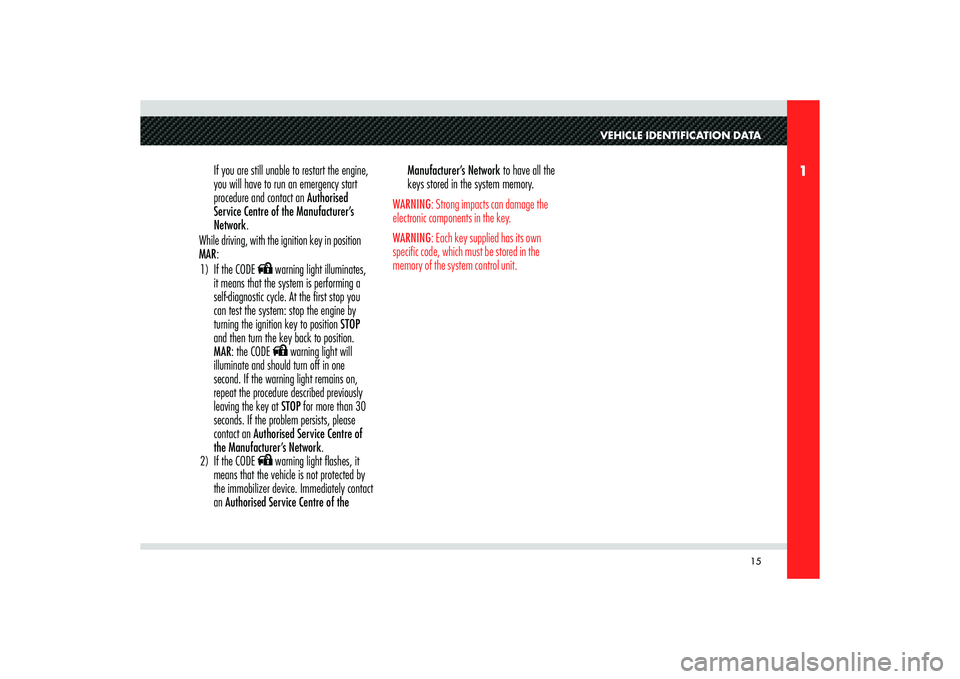
15
1
VEHICLE IDENTIFICATION DATA
If you are still unable to restart the engine,
you will have to run an emergency start
procedure and contact an Authorised
Service Centre of the Manufacturer’s
Network.
While driving, with the ignition key in position
MAR:
1) If the CODE
warning light illuminates,
it means that the system is performing a
self-diagnostic cycle. At the fi rst stop you
can test the system: stop the engine by
turning the ignition key to position STOP
and then turn the key back to position.
MAR: the CODE warning light will
illuminate and should turn off in one
second. If the warning light remains on,
repeat the procedure described previously
leaving the key at STOP for more than 30
seconds. If the problem persists, please
contact an Authorised Service Centre of
the Manufacturer’s Network.
2) If the CODE warning light fl ashes, it
means that the vehicle is not protected by
the immobilizer device. Immediately contact
an Authorised Service Centre of the Manufacturer’s Network to have all the
keys stored in the system memory.
WARNING: Strong impacts can damage the
electronic components in the key.
WARNING: Each key supplied has its own
specifi c code, which must be stored in the
memory of the system control unit.
Page 20 of 223
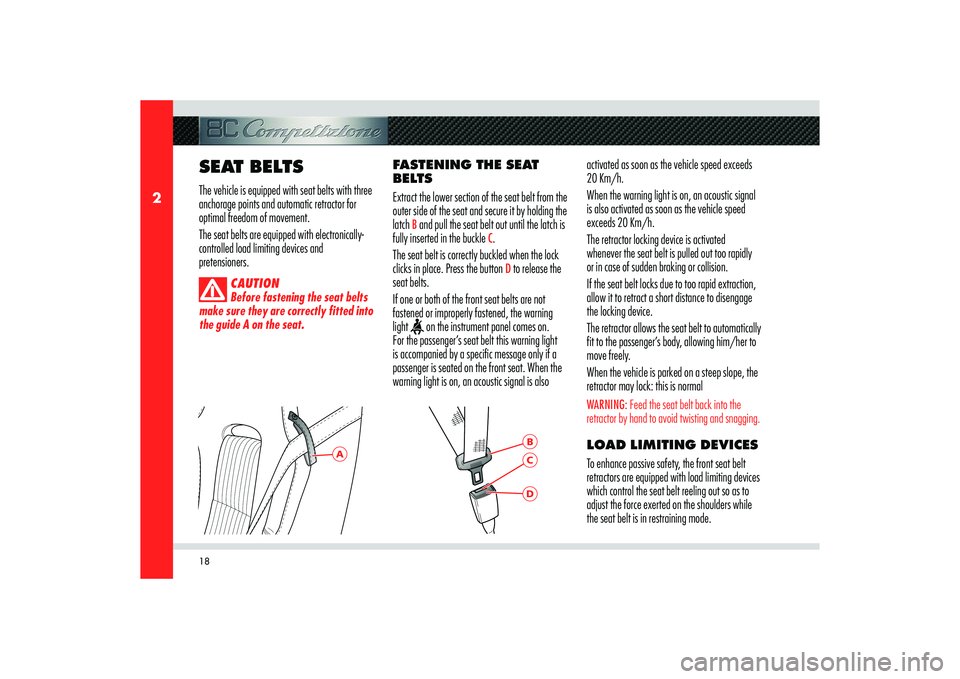
18
2
A
BDC
SEAT BELTS The vehicle is equipped with seat belts with three
anchorage points and automatic retractor for
optimal freedom of movement.
The seat belts are equipped with electronically-
controlled load limiting devices and
pretensioners.
CAUTION
Before fastening the seat belts
make sure they are correctly fitted into
the guide A on the seat.
FASTENING THE SEAT
BELTS
Extract the lower section of the seat belt from the
outer side of the seat and secure it by holding the
latch
B and pull the seat belt out until the latch is
fully inserted in the buckle
C.
The seat belt is correctly buckled when the lock
clicks in place. Press the button
D to release the
seat belts.
If one or both of the front seat belts are not
fastened or improperly fastened, the warning
light
on the instrument panel comes on.
For the passenger’s seat belt this warning light
is accompanied by a specific message only if a
passenger is seated on the front seat. When the
warning light is on, an acoustic signal is also activated as soon as the vehicle speed exceeds
20 Km/h.
When the warning light is on, an acoustic signal
is also activated as soon as the vehicle speed
exceeds 20 Km/h.
The retractor locking device is activated
whenever the seat belt is pulled out too rapidly
or in case of sudden braking or collision.
If the seat belt locks due to too rapid extraction,
allow it to retract a short distance to disengage
the locking device.
The retractor allows the seat belt to automatically
fit to the passenger’s body, allowing him/her to
move freely.
When the vehicle is parked on a steep slope, the
retractor may lock: this is normal
WARNING: Feed the seat belt back into the
retractor by hand to avoid twisting and snagging.LOAD LIMITING DEVICES
To enhance passive safety, the front seat belt
retractors are equipped with load limiting devices
which control the seat belt reeling out so as to
adjust the force exerted on the shoulders while
the seat belt is in restraining mode.
Page 21 of 223
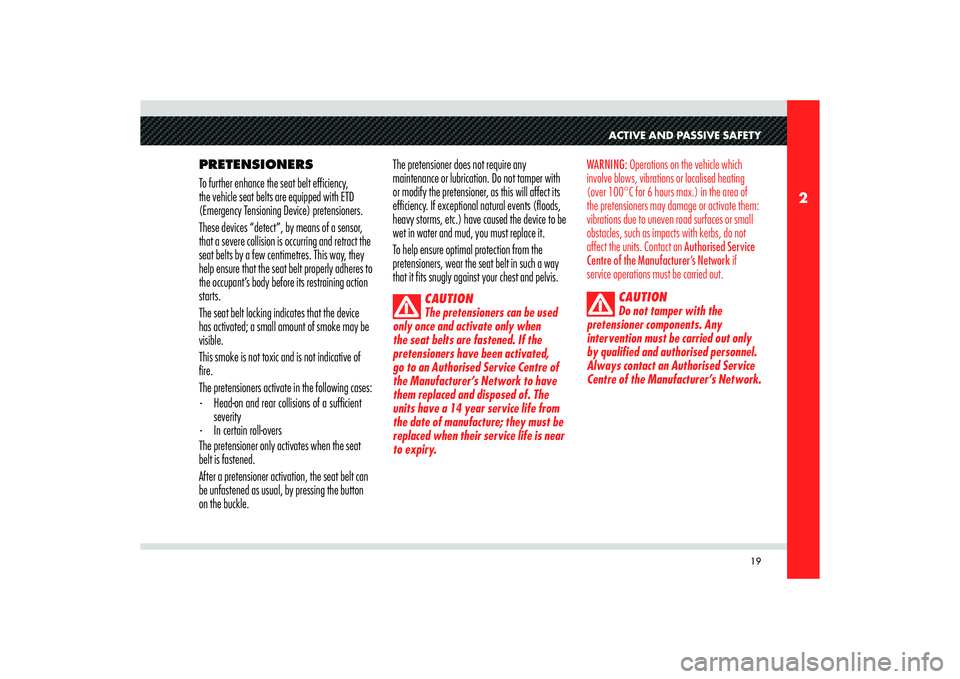
19
2
ACTIVE AND PASSIVE SAFETY
PRETENSIONERS
To further enhance the seat belt efficiency,
the vehicle seat belts are equipped with ETD
(Emergency Tensioning Device) pretensioners.
These devices “detect”, by means of a sensor,
that a severe collision is occurring and retract the
seat belts by a few centimetres. This way, they
help ensure that the seat belt properly adheres to
the occupant’s body before its restraining action
starts.
The seat belt locking indicates that the device
has activated; a small amount of smoke may be
visible.
This smoke is not toxic and is not indicative of
fire.
The pretensioners activate in the following cases:
- Head-on and rear collisions of a suffi cient
severity
- In certain roll-overs
The pretensioner only activates when the seat
belt is fastened.
After a pretensioner activation, the seat belt can
be unfastened as usual, by pressing the button
on the buckle.The pretensioner does not require any
maintenance or lubrication. Do not tamper with
or modify the pretensioner, as this will affect its
efficiency. If exceptional natural events (floods,
heavy storms, etc.) have caused the device to be
wet in water and mud, you must replace it.
To help ensure optimal protection from the
pretensioners, wear the seat belt in such a way
that it fits snugly against your chest and pelvis.
CAUTION
The pretensioners can be used
only once and activate only when
the seat belts are fastened. If the
pretensioners have been activated,
go to an Authorised Service Centre of
the Manufacturer’s Network to have
them replaced and disposed of. The
units have a 14 year service life from
the date of manufacture; they must be
replaced when their service life is near
to expiry. WARNING: Operations on the vehicle which
involve blows, vibrations or localised heating
(over 100°C for 6 hours max.) in the area of
the pretensioners may damage or activate them:
vibrations due to uneven road surfaces or small
obstacles, such as impacts with kerbs, do not
affect the units. Contact an Authorised Service
Centre of the Manufacturer’s Network if
service operations must be carried out.
CAUTION
Do not tamper with the
pretensioner components. Any
intervention must be carried out only
by qualified and authorised personnel.
Always contact an Authorised Service
Centre of the Manufacturer’s Network.
Page 22 of 223
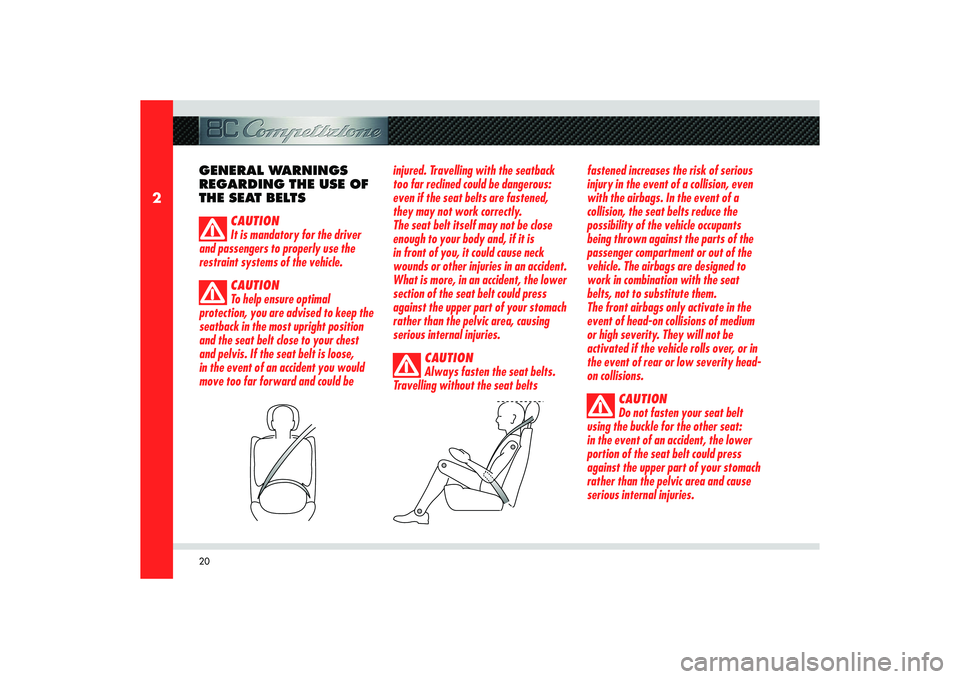
20
2
GENERAL WARNINGS
REGARDING THE USE OF
THE SEAT BELTS
CAUTION
It is mandatory for the driver
and passengers to properly use the
restraint systems of the vehicle.
CAUTION
To help ensure optimal
protection, you are advised to keep the
seatback in the most upright position
and the seat belt close to your chest
and pelvis. If the seat belt is loose,
in the event of an accident you would
move too far forward and could be injured. Travelling with the seatback
too far reclined could be dangerous:
even if the seat belts are fastened,
they may not work correctly.
The seat belt itself may not be close
enough to your body and, if it is
in front of you, it could cause neck
wounds or other injuries in an accident.
What is more, in an accident, the lower
section of the seat belt could press
against the upper part of your stomach
rather than the pelvic area, causing
serious internal injuries.
CAUTION
Always fasten the seat belts.
Travelling without the seat belts fastened increases the risk of serious
injury in the event of a collision, even
with the airbags. In the event of a
collision, the seat belts reduce the
possibility of the vehicle occupants
being thrown against the parts of the
passenger compartment or out of the
vehicle. The airbags are designed to
work in combination with the seat
belts, not to substitute them.
The front airbags only activate in the
event of head-on collisions of medium
or high severity. They will not be
activated if the vehicle rolls over, or in
the event of rear or low severity head-
on collisions.
CAUTION
Do not fasten your seat belt
using the buckle for the other seat:
in the event of an accident, the lower
portion of the seat belt could press
against the upper part of your stomach
rather than the pelvic area and cause
serious internal injuries.
Page 24 of 223
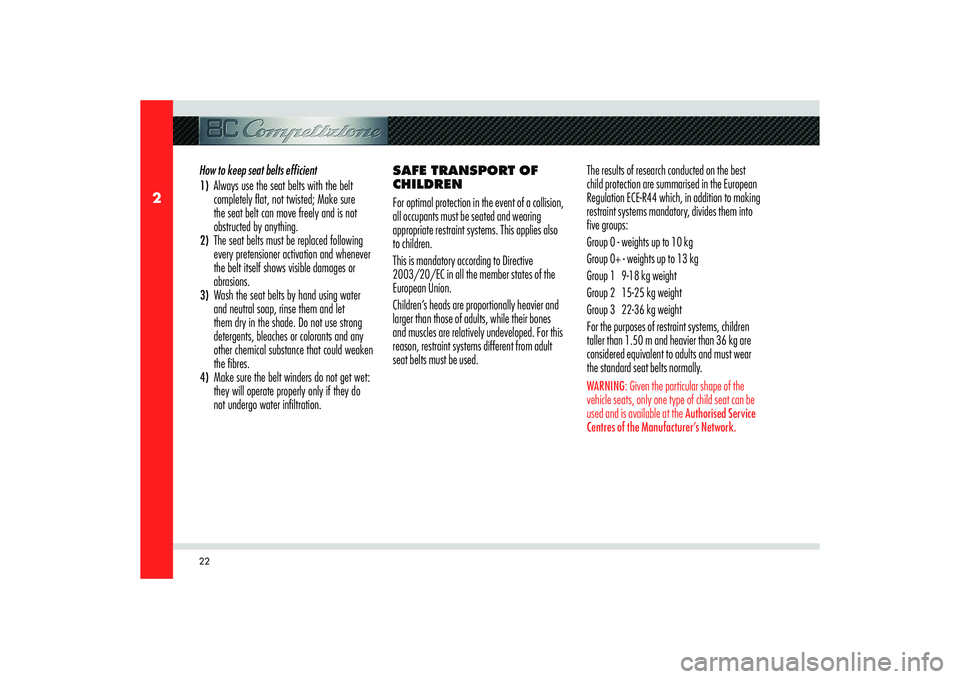
22
2
How to keep seat belts effi cient
1) Always use the seat belts with the belt
completely fl at, not twisted; Make sure
the seat belt can move freely and is not
obstructed by anything.
2) The seat belts must be replaced following
every pretensioner activation and whenever
the belt itself shows visible damages or
abrasions.
3) Wash the seat belts by hand using water
and neutral soap, rinse them and let
them dry in the shade. Do not use strong
detergents, bleaches or colorants and any
other chemical substance that could weaken
the fi bres.
4) Make sure the belt winders do not get wet:
they will operate properly only if they do
not undergo water infi ltration. SAFE TRANSPORT OF
CHILDREN
For optimal protection in the event of a collision,
all occupants must be seated and wearing
appropriate restraint systems. This applies also
to children.
This is mandatory according to Directive
2003/20/EC in all the member states of the
European Union.
Children’s heads are proportionally heavier and
larger than those of adults, while their bones
and muscles are relatively undeveloped. For this
reason, restraint systems different from adult
seat belts must be used.The results of research conducted on the best
child protection are summarised in the European
Regulation ECE-R44 which, in addition to making
restraint systems mandatory, divides them into
five groups:
Group 0 - weights up to 10 kg
Group 0+ - weights up to 13 kg
Group 1 9-18 kg weight
Group 2 15-25 kg weight
Group 3 22-36 kg weight
For the purposes of restraint systems, children
taller than 1.50 m and heavier than 36 kg are
considered equivalent to adults and must wear
the standard seat belts normally.
WARNING: Given the particular shape of the
vehicle seats, only one type of child seat can be
used and is available at the Authorised Service
Centres of the Manufacturer’s Network.